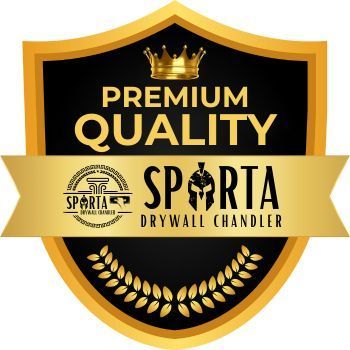Drywall Mudding Services in Chandler, Arizona
You want your Chandler, AZ, home to look its best, and hanging sheetrock can be highly beneficial. However, mudding drywall is something you’ll need to consider, and it’s important to understand the many options.
There are many types of joint compound products you might use for your project, which you’ll learn about below. Likewise, you can discover the cost of mudding, making it easier to create a budget that meets your needs.
It’s important to use a reputable company to help you with the drywall mud finishing process. Contact Sparta Drywall Chandler for assistance today.

Sparta Drywall Chandler (Home Page)

What Are the Types of Drywall Mud Available?
You’ll find many options for drywall mud, and we’ll discuss them below:
- All-purpose Compound – All-purpose mud is premixed and sold in boxes or buckets. You can use it for any phase, but it’s the best joint compound for skim coating because it features a slow dry time and is lightweight.
- Topping Compound – Topping compound is suitable after the first two coatings of the taping mud are applied to the drywall joint.
- Taping Compound – Taping compound is suitable for embedding the tape after finishing the drywall joints. It’s ideal for covering plaster cracks.
- Quick-setting Compound – Hot mud sets quickly and is suitable when finishing a job fast or applying many coats in one day.
- Powder (Dry) Compound – Dry joint compound is considered the classic type, and many professionals still use it because it is less expensive and has a long shelf life.
- Premixed (Wet) Compound – Wet compound comes in plastic buckets, and you don’t have to use extra tools to mix it. However, it can mold and can’t be frozen.
Many people think that spackle is the same as drywall compound, but they are two different things. Though you can apply both with a putty knife, the former primarily covers holes, while the latter offers a smooth finish.
Drywall Mud – The Process and Tools Used
You’ll need various tools to apply drywall mud smoothly. These include:
- A joint compound mixer (power drill with a mixing paddle)
- Mud pan (container holding the compound)
- Drywall knives (wide and flat blades in various sizes)
- Corner trowel (ideal for corners and edges)
- Taping banjo (similar to a tape dispenser but contains mud)
- Sander (removes bumps and imperfections)
Now that you know which tools are needed, it’s time to learn about the mudding process. Here are the steps professionals use:
- Fill Joints and Screw Spots – Each drywall sheet has a beveled edge, which allows the professional to use a utility knife to apply mud between the joints and over the screws.
- Apply the Tape and Smooth It – You must put paper drywall tape over the joint mud, embedding it into the compound and removing air bubbles.
- Apply Mud and Tape on Edges and Corners – Don’t forget to apply tape and mud on the edges and corners with a corner trowel and utility knife.
- Apply Another Coat of Mud – Apply another coating of mud evenly across the entire surface. Let it dry overnight.
- Apply the Final Coating – Apply the third coat of drywall compound on imperfections, and let it dry.
- Sand Everything – Sanding the drywall is the last step. Make sure it’s all smooth.
What Does It Cost to Mud Drywall?
The cost per square foot to tape and mud drywall is $0.35 to $1.10, which is often included in the finishing price. There are many factors that determine how much you pay, which include:
- Type of Mud Used – There are many types of drywall compound products, and each one serves a specific purpose. The professional will determine what’s right for your situation, but the price can vary.
- Labor – Contractors often estimate the cost of labor based on the finish level and project size. Taping and mudding usually costs 40 to 70 cents per square foot.
- Number of Corners – If you have rounded corners and other complex architecture, expect to spend more for mudding and taping.
- Texture Applications – When you decide to add texture, you’ll spend more, though this offers many benefits.
Benefits of Drywall Mudding
Mudding is a crucial part of the drywall installation process. Here are a few benefits to consider:
- Strengthens Drywall – Mudding can strengthen the drywall, which prevents it from cracking.
- Offers a Smooth Appearance – Without mudding, you would see the seams between the sheets, and it might look uneven.
- Provides Fire Resistance – When you fill the gaps between the drywall sheets, you create a barrier. This could slow the spread of fire.
Common Issues Caused by Improper Mudding
Improper mudding can lead to many drywall finishing issues, such as:
- Joint Compound Too Thick – In most cases, you’ll need three coats of the joint compound to close gaps, cover fasteners, and provide a smooth surface. If it’s too thick, the mud is difficult to work with and lumpy, leaving behind imperfections once dry.
- Mudding Too Thin – If you mix the mud too thin, tape will not adhere properly causing cracks in the seams and corners.
- Not Allowing the Mud to Dry – If you don’t let the mud dry and try to sand it, you might damage the drywall.
Where to Find Help with Drywall Mudding
Drywall finishing is essential to have a beautiful space. However, you shouldn’t do it alone. In fact, it’s wise to hire a professional; they have the tools and knowledge needed.
Hiring a drywall contractor is the best solution, and Sparta Drywall Chandler is an excellent choice. We can help you install sheetrock quickly and efficiently!

